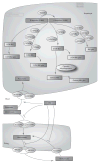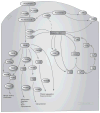PharmGKB summary: ibuprofen pathways
- PMID: 25502615
- PMCID: PMC4355401
- DOI: 10.1097/FPC.0000000000000113
PharmGKB summary: ibuprofen pathways
Conflict of interest statement
R.B.A. and T.E.K. are stockholders in Personalis Inc. For the remaining authors, there are no conflicts of interest.
Figures


Similar articles
-
[Ibuprofen: safety and efficiency of its use in wide clinical practice].Ter Arkh. 2013;85(3):118-24. Ter Arkh. 2013. PMID: 23720856 Review. Russian.
-
Intravenous ibuprofen (Caldolor).Med Lett Drugs Ther. 2010 Jan 11;52(1329):3-4. Med Lett Drugs Ther. 2010. PMID: 20208470 No abstract available.
-
The case for an adverse interaction between aspirin and non-steroidal anti-inflammatory drugs: is it time to believe the hype?J Am Coll Cardiol. 2004 Mar 17;43(6):991-3. doi: 10.1016/j.jacc.2004.01.001. J Am Coll Cardiol. 2004. PMID: 15028355 No abstract available.
-
Effect of ibuprofen on cardioprotective effect of aspirin.Lancet. 2003 May 3;361(9368):1560; author reply 1561. doi: 10.1016/S0140-6736(03)13191-1. Lancet. 2003. PMID: 12737889 No abstract available.
-
Ibuprofen: from invention to an OTC therapeutic mainstay.Int J Clin Pract Suppl. 2013 Jan;(178):9-20. doi: 10.1111/ijcp.12055. Int J Clin Pract Suppl. 2013. PMID: 23163543 Review.
Cited by
-
Ibuprofen Favors Binding of Amyloid-β Peptide to Its Depot, Serum Albumin.Int J Mol Sci. 2022 May 31;23(11):6168. doi: 10.3390/ijms23116168. Int J Mol Sci. 2022. PMID: 35682848 Free PMC article.
-
Metabolic-Hydroxy and Carboxy Functionalization of Alkyl Moieties in Drug Molecules: Prediction of Structure Influence and Pharmacologic Activity.Molecules. 2020 Apr 22;25(8):1937. doi: 10.3390/molecules25081937. Molecules. 2020. PMID: 32331223 Free PMC article. Review.
-
Evaluation of Phenotypic and Genotypic Variations of Drug Metabolising Enzymes and Transporters in Chronic Pain Patients Facing Adverse Drug Reactions or Non-Response to Analgesics: A Retrospective Study.J Pers Med. 2020 Oct 27;10(4):198. doi: 10.3390/jpm10040198. J Pers Med. 2020. PMID: 33121061 Free PMC article.
-
Bioequivalence Study of Ibuprofen and Diphenhydramine Hydrochloride mini liquid-filled capsules: A Size Reduction Alternative.Curr Ther Res Clin Exp. 2025 Feb 12;102:100779. doi: 10.1016/j.curtheres.2025.100779. eCollection 2025. Curr Ther Res Clin Exp. 2025. PMID: 40123879 Free PMC article.
-
Potential Effects of Ibuprofen, Remdesivir and Omeprazole on Dexamethasone Metabolism in Control Sprague Dawley Male Rat Liver Microsomes (Drugs Often Used Together Alongside COVID-19 Treatment).Molecules. 2022 Mar 30;27(7):2238. doi: 10.3390/molecules27072238. Molecules. 2022. PMID: 35408639 Free PMC article.
References
-
- Davies NM. Clinical pharmacokinetics of ibuprofen. The first 30 years. Clin Pharmacokinet. 1998;34:101–154. - PubMed
-
- Rainsford KD. Ibuprofen: pharmacology, efficacy and safety. Inflammopharmacology. 2009;17:275–342. - PubMed
-
- Pierce CA, Voss B. Efficacy and safety of ibuprofen and acetaminophen in children and adults: a meta-analysis and qualitative review. Ann Pharmacother. 2010;44:489–506. - PubMed
-
- Evans AM, Nation RL, Sansom LN, Bochner F, Somogyi AA. The relationship between the pharmacokinetics of ibuprofen enantiomers and the dose of racemic ibuprofen in humans. Biopharm Drug Dispos. 1990;11:507–518. - PubMed
Publication types
MeSH terms
Substances
Grants and funding
LinkOut - more resources
Full Text Sources
Other Literature Sources

